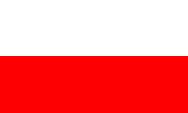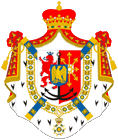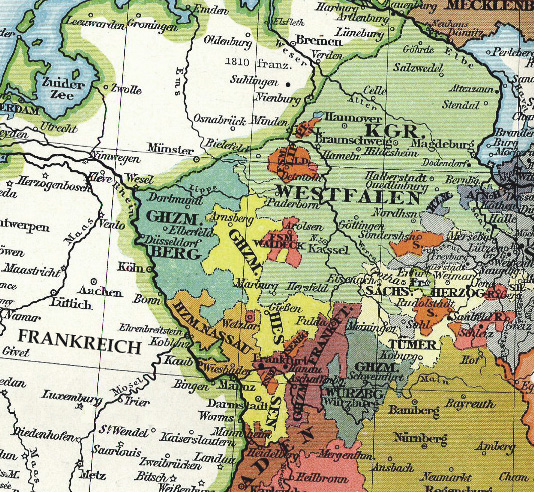mobile View, to the German Version tap the flag


- Grand Duchy of Berg, French: Grand-Duché de Berg
- 1806–1813 existend Napoléonic satellite state
- Member of the Rhine Confederation
- even: Cleves-Berg
• Flag
• Meaning/Origin of the Flag
• Coat of Arms
• Meaning/Origin of the Coat of Arms
• Map
• Numbers and Facts
• History
• Origin of the Country's Name

1806–1813,
Flag of the country (Colours of the country),
Source, by: Wikipedia (D)





The colors of Westphalia had been white and red. They are deived from the coat of arms of the country, the red shield of Kleve, the wihte shield for Berg.
Source: Volker Preuß


1806–1813,
Coat of arms the Grand Duchy of Berg,
Source:
Wikipedia (D)

The arms of the Grand Duchy of Berg shows the heraldry of those countries, which had been incorporated into the country. It can be seen: to the left the Duchy of Berg (red lion on silver), on the right the Duchy of Kleve (red shield). On the crest coat lies a Napoleonic medal, and the coat is covered with golden bees. The honey bee was the personal emblem of Napoleon Bonaparte, so to speak the animal emblem of the person N. Bonaparte, the eagle was the official armor of the emperor in (West-)Roman, Franconian tradition. The award of golden bees for inclusion into coats of arms was a special form of honoring by Napoléon for meritorious persons, countries or cities, e.g. the Island of Elba.
Source:
Volker Preuß,
Jürgen Kaltschmitt,
nearbees.de


Source: F. W. Putzgers Historischer Schul-Atlas

Area: 6.680 square miles (1811)
Inhabitants: 880.000 (1811)
Capital: Düsseldorf
official Languages: German, French
Currency: Berg Franken (from 1810)
Source: Wikipedia (D)

1792, 1796, 1800 and 1805 · invasions of French revolutionary troops under Napoleon in the German Empire, the German Empire subjectes and becomes territorially transformed
1801 · all left-bank territories of the River Rhine ceded to France, and incorporated by this
1803 · German Mediatisation (Reichsdeputationshauptschluss), transformation of the territorial partition of the German Empire, ecclesiastical possessions become confiscated, old princely territories and free cities become confiscated or dissolved or annexed to old or new principalities, the number of sovereign authorities and territorial entities of the empire is thus reduced from 300 to 60
15th of March in 1806 · King Maximilian I. Joseph of Bavaria cedes the Duchy of Berg, and the King of Prussia cedes the Duchy of Cleves to Napoleon, he summarizes both areas to the Duchy of Berg (also Duchy of Cleves-Berg) and hands it over to his brother-in-law Murat
12th of July in 1806 · Napoleon forces the creation of the Rhine Confederation, an alliance of sixteen southern and southwestern German states under French protectorate, the Duchy of Berg is one of the founding members
1st of August 1806 · the states of the Rhine Confederation declare themselves sovereign and resign from the Holy Roman Empire of German Nation, Berg becomes Grand Duchy
6th of August in 1806 · Emperor Franz II. lays down the crown of the Holy Roman Empire of German Nation, the empire ends
7th of July in 1807 · Peace of Tilsit, Prussia must cede large areas to France, which become annexed together with other lands until 1808 to the Grand Duchy of Berg
15th of July in 1808 · Napoléon appoints Grand Duke Murat to the King of Naples, and sets himself up as Grand Duke of Berg (in personal union as Emperor of France)
3rd of March in 1809 · Napoleon appoints his four years old nephew Louis Napoleon Bonaparte to the Grand Duke of Berg, however, he remains as regent
13th of December in 1810 · the areas of Berg northern the river Lippe become annexed by France
Spring 1813 · anti-French riots become precipitated
October 1813 · Napoleon's defeat at Leipzig, the French abandone the Grand Duchy
10th of November 1813 · marching-in of Russian troops in Duesseldorf
25th of November in 1813 · Prussia transforms the Grand Duchy of Berg to the Gouvernement General of Berg, Prussia annexes the Rhineland
30th of April in 1815 · Prussia builts from its North Rhine areas the province of Juelich-Cleves-Berg
22nd of June in 1822 · Prussia merges the provinces of Juelich-Cleves-Berg and Lower Rhine to the Prussian Rhine Province
Source: Wikipedia (D),
Discovery '97

The name "Berg" goes back to the family of the Counts of Berg, which were headquartered in the 11th Century in the Castle Berge at Altenburg. The county was levied in 1380 to the Duchy of Berg. 1510 followed the union with the Duchy of Juelich the Duchy of Juelich-Berg, and in 1521 the Duchy came to the House of Cleves, and it arised the Duchy of Juelich-Cleves-Berg. In 1609 the lineage vanishes, and Berg came to the Bavarian Wittelsbach dynasty.
Source: Wikipedia (D)


![]()






